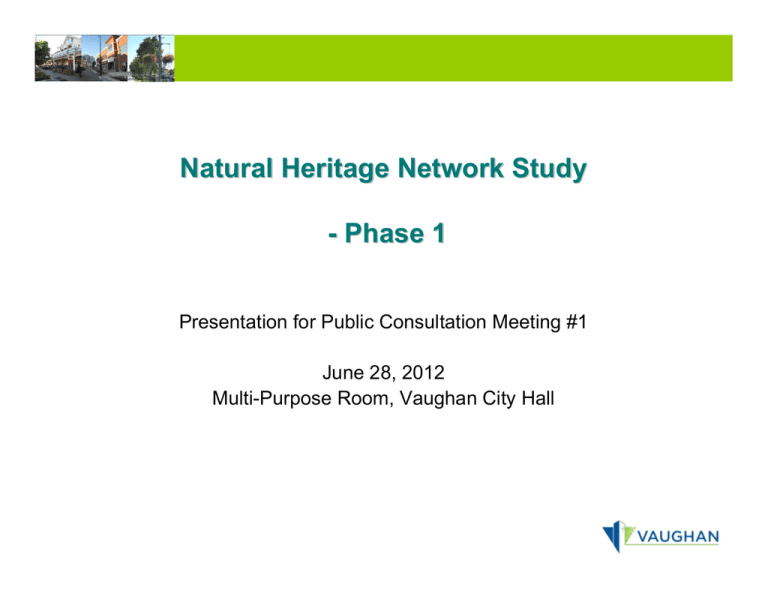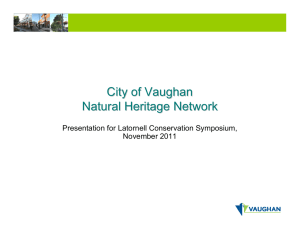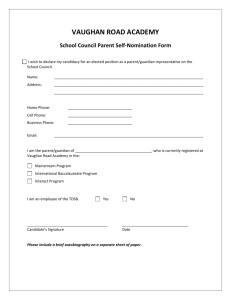Policy Background Presentation
advertisement

Natural Heritage Network Study - Phase 1 Presentation for Public Consultation Meeting #1 June 28, 2012 Multi-Purpose Room, Vaughan City Hall VOP 2010: Overview THE FOUR COMPONENTS OF VAUGHAN TOMORROW • Vaughan Vision 20/20 – The City’s Strategic Plan • The originating document for Vaughan Tomorrow • Green Directions Vaughan – The Community Sustainability and Environmental Master Plan; • VOP 2010 – The City’s land use, design and development plan to guide the growth of the City to 2031 • The Master Plans – Dealing with services and infrastructure to support the preparation VOP 2010 and its implementation. 2 Urban Structure A NEW PROVINCIAL AND REGIONAL PLANNING FRAMEWORK IS IN PLACE PLANNING FRAMEWORK • Apply Provincial/Regional growth forecasts • Protect Greenbelt and other Countryside/Natural Features • Set intensification targets • Identify any employment land use conversions • Minimize urban boundary expansions • Vaughan allocated: – 416, 600 population – 266,100 employment 3 Urban Structure 36% of Vaughan is maintained as Community Areas LAND USE DESIGNATIONS • • • • • • • 4 Low-Rise Residential Low-Rise Mixed-Use Mid-Rise Residential Mid-Rise Mixed-Use High-Rise Residential Community and Employment Commercial Mixed-Use New Community Areas Urban Structure 20% of Vaughan is designated as Employment Areas to support economic and job growth LAND USE DESIGNATIONS • • • General Employment Prestige Employment Employment Commercial Mixed-Use NEW EMPLOYMENT AREAS • • 5 400 North Employment Area (OPA 637) West Vaughan Employment Area Secondary Plan Urban Structure EXPANSION AREAS 3% urban boundary expansion 6 • New Community Areas (Blocks 41 & 27) • Council Resolution for Phasing of New Community Areas (revised June 2012) • Hwy 400 North Employment Area • Expansion areas will require a Secondary Plan and Block Plans • GTA West Transportation Corridor Urban Structure 40% of Vaughan is protected as Green/Open Space: Natural Areas and Countryside LAND USE DESIGNATIONS • • • • • • 7 Permitted land uses within Oak Ridges Moraine Plan and Greenbelt Plan Natural Areas Parks Private Open Spaces Agricultural Rural Urban Structure PROVINCIAL: OAK RIDGES MORAINE & GREENBELT 8 Natural Heritage Network (NHN) and Natural Heritage Systems Planning NHN Study NATURAL HERITAGE NETWORK 20 10 NHN Study PROVINCIAL POLICY STATEMENT • 2.1.2 The diversity and connectivity of natural features in an area, and the longterm ecological function and biodiversity of natural heritage systems, should be maintained, restored or, where possible, improved, recognizing linkages between and among natural heritage features and areas, surface water features and ground water features. • 11 Natural heritage system: means a system made up of natural heritage features and areas, linked by natural corridors which are necessary to maintain biological and geological diversity, natural functions, viable populations of indigenous species and ecosystems. These systems can include lands that have been restored and areas with the potential to be restored to a natural state. NHN Study NATURAL HERITAGE REFERENCE MANUAL As with a features-based approach, systems delineated through a landscape-based approach should be assessed to identify major core areas, linkages and missing attributes. In some cases, a landscapebased approach taken by a planning authority may determine that some previously unevaluated features (e.g., areas that serve as temporary refuges or stepping stones for species movement or provide representation of a wider range of habitats) are “significant” as defined in the PPS, due to their role as part of the identified natural heritage system 12 NHN Study STUDY PHASES • Natural Heritage Network Study – Phase 1 - Clean up existing data and set biodiversity/ecological function targets – Phase 2 – field investigations re Sig. Wildlife Habitat and headwaters evaluation – Phases 3 and 4 – Final Report with scan of land securement approaches • Environmental Management Guidelines – Focus on scope of MESP and EIS given the Natural Heritage Network 13 NHN Study NHN PHASE 1 TASKS • inventory of the NHN constituent parts compiled in a comprehensive GIS database; • setting ecosystem targets; • undertaking a gap assessment of the biodiversity contribution and ecological functions of the existing NHN against the ecosystem targets; • bringing forward the revised Environmental Management Guideline (EMG) for public review and consultation; and • providing recommendations for field investigations in subsequent phases of the study. 14 NHN Study NHN PHASE 1 TIMING • Phase 1 Steering Committee includes York Region, OMNR, TRCA, Development Planning, Information and Technology Management, Parks Development, Development Engineering • November Report to Committee of the Whole for Phase 1 Tasks Comprehensive GIS Database Ecosystem Targets Gap Analysis Environmental Management Guideline Preliminary Methodology for Field Investigations Draft and final report preparation May Jun ∆ ∆ Jul Aug Sep Oct ∆ ∆ ∆ ∆ ∆ • Terms of Reference for Phases 2-4 to future Committee of the Whole 15 NHN Study LEARNING FROM OTHER NATURAL HERITAGE SYSTEM DESIGNS • A systems-based approach to ecological stewardship is consistent with current best practices • Decisions must attempt to achieve an appropriate balance between economic, social and ecological considerations • Corridor enhancement is a priority • A fair process is one based on clear criteria and a transparent process 16 NHN Study ECOSYSTEM TARGETS 17 NHN Study HEADWATERS EVALUATION 18 NHN Study HEADWATERS EVALUATION Endangered Redside Dace 19 NHN Study SIGNIFICANT WILDLIFE HABITAT Habitats of seasonal concentrations of animals Rare vegetation communities or specialized habitat Habitat of species of conservation concern Animal movement corridors 20 NHN Study NEXT STEPS • Summer efforts to define GIS database attributes and ecosystem targets • Draft findings and recommendations to Public Consultation Meeting #2 in September • Report to Committee of the Whole in November 2012 • Continued public consultation in Phases 2, 3 and 4 (adaptive management approach) • Opportunity for residents/landowners to provide site-specific information in Phase 1 and later in Phases 2, 3 and 4. 21 Questions /Comments? Contact Tony Iacobelli Senior Environmental Planner 905-832-8585 ext. 8630 tony.iacobelli@vaughan.ca 22





